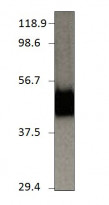ARG10781
anti-GLUT1 antibody
anti-GLUT1 antibody for ELISA,ICC/IF,Immunohistochemistry (PFA perfusion fixed frozen sections),IHC-Frozen sections,IHC-Formalin-fixed paraffin-embedded sections,Immunoprecipitation,Western blot and Human,Mouse,Rat
Overview
| Product Description | Rabbit Polyclonal antibody recognizes GLUT1 |
|---|---|
| Tested Reactivity | Hu, Ms, Rat |
| Tested Application | ELISA, ICC/IF, IHC-FoFr , IHC-Fr, IHC-P, IP, WB |
| Host | Rabbit |
| Clonality | Polyclonal |
| Isotype | IgG |
| Target Name | GLUT1 |
| Antigen Species | Human |
| Immunogen | KLH-conjugated synthetic peptide around aa. 478-492 of Human GLUT-1. (PEELFHPLGADSQV) |
| Conjugation | Un-conjugated |
| Alternate Names | DYT17; HepG2 glucose transporter; CSE; GLUT-1; GLUT; GLUT1DS; DYT18; HTLVR; PED; Glucose transporter type 1, erythrocyte/brain; DYT9; EIG12; GLUT1; Solute carrier family 2, facilitated glucose transporter member 1 |
Application Instructions
| Application Suggestion |
|
||||||||||||||||
|---|---|---|---|---|---|---|---|---|---|---|---|---|---|---|---|---|---|
| Application Note | * The dilutions indicate recommended starting dilutions and the optimal dilutions or concentrations should be determined by the scientist. |
Properties
| Form | Liquid |
|---|---|
| Purification | Affinity purified. |
| Buffer | Tris-Glycine Buffer (pH 7.4 - 7.8), Hepes, 0.02% Sodium azide, 30% Glycerol and 0.5% BSA. |
| Preservative | 0.02% Sodium azide |
| Stabilizer | 30% Glycerol and 0.5% BSA |
| Concentration | 0.75 mg/ml |
| Storage Instruction | For continuous use, store undiluted antibody at 2-8°C for up to a week. For long-term storage, aliquot and store at -20°C. Storage in frost free freezers is not recommended. Avoid repeated freeze/thaw cycles. Suggest spin the vial prior to opening. The antibody solution should be gently mixed before use. |
| Note | For laboratory research only, not for drug, diagnostic or other use. |
Bioinformation
| Database Links | |
|---|---|
| Gene Symbol | SLC2A1 |
| Gene Full Name | solute carrier family 2 (facilitated glucose transporter), member 1 |
| Background | This gene encodes a major glucose transporter in the mammalian blood-brain barrier. The encoded protein is found primarily in the cell membrane and on the cell surface, where it can also function as a receptor for human T-cell leukemia virus (HTLV) I and II. Mutations in this gene have been found in a family with paroxysmal exertion-induced dyskinesia. [provided by RefSeq, Apr 2013] |
| Function | Facilitative glucose transporter. This isoform may be responsible for constitutive or basal glucose uptake. Has a very broad substrate specificity; can transport a wide range of aldoses including both pentoses and hexoses. [UniProt] |
| Calculated MW | 54 kDa |
Images (2) Click the Picture to Zoom In
-
ARG10781 anti-GLUT1 antibody WB image
Western blot: 10 µg of Rat brain cortical extracts on 10% SDS-PAGE. Lane 1, 4, 7, 10) untreated for 21 months, Lane 2, 5, 8, 11) Saline treated for 21 months, and Lane 3, 6, 9, 12) CB treated for 21 months. The blots were stained with ARG10781 anti-GLUT1 antibody at 1:2000 dilution (2 hours at RT).
-
ARG10781 anti-GLUT1 antibody WB image
Western blot: Recombinant GLUT-1 protein stained with ARG10781 anti-GLUT1 antibody at 1:2000 dilution.









